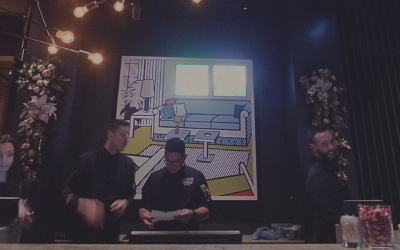As a restaurant operator or owner, you’re no stranger to the challenges of running a successful business. From improving customer satisfaction to managing inventory, every day presents a new opportunity to optimize operations. In 2025, one of the most powerful tools at your disposal will be your Point of Sale (POS) system. Far more than just a way to process payments, today’s POS technology is transforming the restaurant industry—helping you streamline operations, cut costs, and deliver superior customer experiences. Here’s how POS systems are evolving and why they should be at the heart of your strategy.
- POS Systems: The All-in-One Solution for Restaurant Operations
In 2025, POS technology is more advanced than ever before, offering all-in-one solutions that integrate various aspects of restaurant management. No longer just a payment processing tool, your POS system can handle everything from order taking and payments to inventory tracking and customer data management.
Cloud-based POS systems allow you to access real-time data from anywhere, whether you’re on the floor, at home, or traveling. You can monitor sales performance, track inventory, adjust staff schedules, and analyze customer behavior—all from a single platform. This level of connectivity empowers you to make smarter decisions that directly impact your bottom line.
Why it matters for you: As an operator, simplifying your processes with an all-in-one POS system saves you time, reduces errors, and increases operational efficiency. A more efficient system means less stress for you and your team and a better overall experience for your customers.
- Enhancing Customer Loyalty with Data-Driven Personalization
In today’s competitive dining landscape, personalized service is key to building customer loyalty. In 2025, your POS system will be more powerful than ever in helping you deliver tailored dining experiences that keep customers coming back.
By collecting and analyzing data from past orders, preferences, and visit history, modern POS systems integrate with loyalty programs to offer personalized promotions, custom recommendations, and rewards. For example, if a regular customer orders the same dish on every visit, your POS can automatically suggest it next time, enhancing the customer’s experience and increasing the chances of upselling.
Why it matters for you: As a restaurant owner, a personalized customer experience builds loyalty and boosts your revenue. By using data from your POS system, you can create targeted promotions, enhance customer satisfaction, and drive repeat business without adding extra complexity to your operations.
- Streamlining Payments and Improving Speed with Contactless Solutions
Customers today expect quick, seamless transactions, and contactless payments are becoming the norm. In 2025, the integration of mobile wallets, QR code ordering, and NFC (Near Field Communication) technology into POS systems will ensure that your customers can pay quickly and securely without the need for physical contact.
Whether your customers choose to use their smartphones, smartwatches, or credit cards, POS systems will offer a variety of fast and secure payment options. This reduces wait times, speeds up table turnover, and enhances customer satisfaction.
Why it matters for you: Faster, frictionless transactions improve your restaurant’s operational efficiency and reduce long queues at checkout. A seamless payment experience also enhances your restaurant’s reputation for being up-to-date with the latest trends, keeping customers coming back for convenience and speed.
- Increasing Order Accuracy and Speed Through POS Integration
As a restaurant operator, you know that accuracy in order taking is essential to delivering great customer service. Modern POS systems are integrated with kitchen display systems (KDS) and can automatically send orders to the kitchen, ensuring faster, more accurate communication between servers and kitchen staff.
These systems also track modifications and special requests in real-time, reducing human error and the chances of mix-ups. Whether it’s a change in the dish or a specific dietary requirement, your POS system ensures that the kitchen is always in the loop.
Why it matters for you: Integrating your POS with KDS and order management systems minimizes mistakes, improves service speed, and ensures customers get exactly what they ordered. As a result, you’ll reduce food waste, improve service quality, and keep your team focused on delivering a great experience.

- Leveraging AI for Smarter Decisions and Streamlined Operations
Artificial intelligence (AI) is no longer a distant future for restaurant operations—it’s here, and it’s transforming the way you run your business. In 2025, POS systems will feature AI-powered analytics that provide you with actionable insights into sales trends, customer preferences, and staff performance.
AI can predict peak dining times, optimize inventory orders, and even help you analyze menu performance. For example, if a certain dish isn’t selling as well as expected, your POS can suggest discounts or promotions to move inventory, or flag that it may be time to adjust the menu.
Why it matters for you: AI-driven insights allow you to make data-backed decisions quickly. Whether it’s optimizing staffing during busy hours or adjusting your menu to reflect customer preferences, AI helps you stay ahead of trends and adapt on the fly, keeping your restaurant profitable and efficient.
- Seamless Online Ordering and Delivery Integration
The rise of online ordering and third-party delivery services has changed the restaurant landscape. Your POS system will continue to integrate with delivery platforms and online ordering systems, ensuring that orders from multiple channels (in-house, takeout, and delivery) are processed seamlessly.
In 2025, many POS systems will allow you to manage both dine-in and delivery orders from a single interface, eliminating confusion and reducing the risk of duplicate or missed orders. This integration will help you streamline your kitchen operations and improve overall efficiency, particularly during peak hours.
Why it matters for you: As a restaurant operator, managing multiple order channels can be a challenge, but POS integration makes it easy to stay organized and ensure smooth operations. It will also help you offer a more reliable and consistent service to customers, whether they’re dining in or ordering from home.
- Inventory Management Made Easy with POS Integration
Inventory management has always been a headache for restaurant owners, but with the latest POS systems, tracking and managing your stock has never been easier. In 2025, POS technology will automatically track ingredient usage, update stock levels, and even generate inventory reports in real-time.
By linking your POS to your suppliers, some systems can even predict when you’ll need to restock and automatically place orders for you, ensuring that you never run out of key ingredients. This automated approach helps reduce waste, avoid overordering, and keep costs in check.
Why it matters for you: As a restaurant operator, you need to keep your food costs under control. Automated inventory management through your POS system means fewer stockouts, less waste, and more efficient ordering—ultimately saving you money and improving profitability.
- Improved Employee Scheduling and Labor Management
Labor costs are one of the largest expenses for any restaurant, and in 2025, your POS system will help you manage staffing more effectively. Modern POS systems can integrate with scheduling software, allowing you to create and adjust employee shifts based on real-time data about customer traffic and sales trends.
With built-in timekeeping features, POS systems can automatically track employee hours and help streamline payroll processing, ensuring that you stay compliant with labor laws and avoid overstaffing during slow periods.
Why it matters for you: Efficient labor management is crucial to controlling costs. With POS-powered scheduling and time tracking, you can ensure that you have the right number of employees on the floor at the right time, improving service levels while minimizing unnecessary labor costs.
- Flexibility to Adapt to New Trends and Customer Expectations
Restaurant consumers are constantly evolving, and staying relevant means adapting quickly to trends and customer expectations. In 2025, POS systems will be more flexible than ever, allowing you to update menus, pricing, and promotions in real-time to respond to customer demand.
Whether it’s adjusting your menu for seasonal changes, offering discounts during off-peak times, or launching new promotional campaigns, your POS system gives you the ability to be agile and responsive.
Why it matters for you: As an owner, adapting to changing trends and customer demands is critical to staying competitive. Your POS system helps you remain agile and responsive to the ever-evolving restaurant landscape, keeping your business fresh and appealing to both new and loyal customers.
Conclusion: Embrace POS Technology for a Stronger Future
As we move into 2025, Point of Sale systems are evolving from simple transaction tools into comprehensive, data-driven solutions that can transform every aspect of your restaurant operations. By embracing the latest POS technology, you can streamline processes, enhance customer experiences, and make smarter business decisions.
For restaurant operators and owners, the right POS system isn’t just a convenience—it’s a powerful tool that can help you save time, reduce costs, and stay ahead of the competition. Invest in the future of your restaurant by adopting POS technology that empowers your business and delivers results.
*Sources




